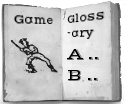Gulli-Danda
| Game | Gulli-Danda |
|---|---|
| Game Family | Fungo |
| Location | |
| Regions | Rest of World |
| Eras | Pre-1700, Predecessor |
| Invented | No |
| Tags | |
| Description | An apparent non-running relative of tip-cat. A batter hits a gulli (a six-inch cat) with a danda, and is out if a fielder catches it. If it falls to the ground, a fielder throws it back, trying to hit the danda, which is laid on the ground. It is not clear if this is a team game, or if the gulli is pitched on simply fungoed. There is no running. The geographical range of its play is unclear, but seems to be centered on India and southeast Asia. |
| Sources | Wikipedia article on Gillidanda |
| Source Image | [[Image:|left|thumb]] |
| Comment | "Gillidanda is an ancient sport originating from South Asia that is still widely played throughout South Asia. The sport is also found as far north as the Mediterranean and as far east as Southeast Asia. It was a precursor to cricket in South Asia. The game is played with two sticks: a large one called a danda, which is used to hit a smaller one, the gilli. It bears many similarities to bat and ball games such as cricket and baseball. Gullidanda is an ancient sport, possibly with origins over 2500 years ago. Gillidanda is played with two pieces of equipment – a danda, being a long wooden stick, and a gilli, a small oval-shaped piece of wood. It is played with four or more players of even numbers.The boy on left is about to strike the gilli with the danda, while the one on right is fielding. Standing in a small circle, the player balances the gilli on a stone in an inclined manner (somewhat like a see-saw) with one end of the gilli touching the ground while the other end is in the air. The player then uses the danda to hit the gilli at the raised end, which flips it into the air. While it is in the air, the player strikes the gilli, hitting it as far as possible. Having struck the gilli, the player is required to run and touch a pre-agreed point outside the circle before the gilli is retrieved by an opponent. There are no specific dimensions of gillidanda and it does not have a limited number of players. The gilli becomes airborne after it is struck. If a fielder from the opposing team catches the gilli, the striker is out. If the gilli lands on the ground, the fielder closest to the gilli has one chance to hit the danda (which has to be placed on top of the circle used) with a throw (similar to a run out in cricket). If the fielder is successful, the striker is out; if not, the striker scores one point and gets another opportunity to strike. The team (or individual) with the most points wins the game. If the striker fails to hit the gilli in three tries, the striker is out (similar to a strikeout in baseball). After the gilli has been struck, the opposing players need to return to the circle or, in the best case, catch it in mid-air without it hitting the ground – this was believed to have later evolved into a Catch Out in cricket and baseball." Edit with form to add a comment |
| Query | Edit with form to add a query |
| Has Supplemental Text |
Comments
<comments voting="Plus" />
